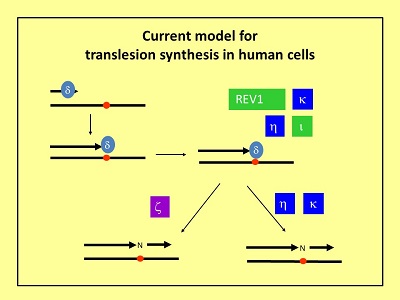Role of specialized DNA polymerases in mutagenesis and DNA repair
Moriya and Hashimoto
 DNA polymerases play a central role in the replication and repair of DNA. Recently, a number of previously unknown DNA polymerases, including pol z, pol h, pol k, and pol i, were identified in human cells. In contrast to pol a and d, which negotiate DNA damage with difficulty, these "new" polymerases catalyze DNA synthesis efficiently, albeit with low fidelity, on damaged templates in vitro. Pol z is responsible for UV-induced mutagenesis. Pol h (XPV), a homolog of Rad30 in yeast, catalyzes error-free bypass of cis-syn pyrimidine dimmers while translesion synthesis across benzo(a)pyrene adducts by pol h is error-prone. Humans lacking pol h exhibit an XP-variant phenotype, which is manifested by hypersensitivity to UV light and increased incidence of skin cancer.
DNA polymerases play a central role in the replication and repair of DNA. Recently, a number of previously unknown DNA polymerases, including pol z, pol h, pol k, and pol i, were identified in human cells. In contrast to pol a and d, which negotiate DNA damage with difficulty, these "new" polymerases catalyze DNA synthesis efficiently, albeit with low fidelity, on damaged templates in vitro. Pol z is responsible for UV-induced mutagenesis. Pol h (XPV), a homolog of Rad30 in yeast, catalyzes error-free bypass of cis-syn pyrimidine dimmers while translesion synthesis across benzo(a)pyrene adducts by pol h is error-prone. Humans lacking pol h exhibit an XP-variant phenotype, which is manifested by hypersensitivity to UV light and increased incidence of skin cancer.
The presence of "translesion" DNA polymerases in eukaryotes raises many important questions. What function(s) do these enzymes play in human cells? Do they contribute to "spontaneous" mutagenesis? Do they work in concert with pol d, pol b, or other polymerases to effect translesion synthesis? We address these and related questions in this research.
- Hashimoto, K., Bonala, R., Johnson, F., Grollman, A.P., and Moriya, M., Y-family DNA polymerase-independent gap-filling translesion synthesis across aristolochic acid-derived adenine adducts in mouse cells, DNA Repair 46, 55-60, 2016. PMID: 27497692
- Hashimoto, K., Wada, K., Matsumoto, K. and Moriya, M., Physical interaction between SLX4 (FANCP) and XPF (FANCQ) proteins and biological consequences of interaction-defective missense mutations, DNA Repair 35, 48-54, 2015. PMID: 26453996
- Hashimoto, K., Cho, Y., Yang, I.-Y., Akagi, J., Ohashi, E., Tateishi, S., de Wind, N., Hanaoka, F., Ohmori, H., and Moriya, M., The vital role of pol z and REV1 in mutagenic, but not correct, DNA synthesis across benzo[a]pyrene-dG and the recruitment of pol z by REV1 to a replication-stalled site, J. Biol. Chem. 287, 9613-9622, 2012. PMID22303021
- Yuan, B., You, C., Andersen, N., Jiang, Y., Moriya, M., O’Connor, T.R. and Wang, Y., The roles of pol κ and polι in the error-free bypass of N2-carboxyalkyl-dG lesions in mammalian cells, J. Biol. Chem. 286, 17503-17511, 2011. PMID21454642
- Attaluri, S., Bonala, R.R., Yang, I.-Y., Lukin, M. A., Wen, Y., Grollman, A. P., Moriya, M., Iden, C.R., and Johnson, F., DNA adducts of aristolochic acid II: total synthesis and site-specific mutagenesis studies in mammalian cells, Nucleic Acids Res. 38, 339-352, 2010. PMID19854934
- Yang, I.-Y., Hashimoto, K., de Wind, N., Blair, I.A. and Moriya, M., Two distinct translesion synthesis pathways across a lipid peroxidation-derived DNA adduct in mammalian cells, J. Biol. Chem. 284, 191-198, 2009. PMID18981176
- Liu, X., Lao, Y., Yang, I.-Y., Hecht, S.S., and Moriya, M., Replication-coupled repair of crotonaldehyde/acetaldehyde-induced guanine-guanine interstrand cross-links and their mutagenicity, Biochemistry 45, 12898-12905, 2006. PMID1704250

